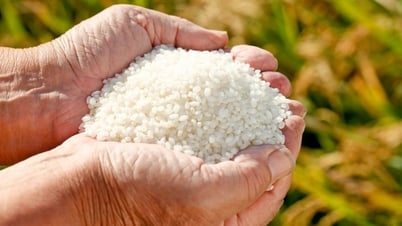According to the Ministry of Health , based on the 2019-2020 nutrition survey results report, micronutrient deficiencies in the community in Vietnam remain high.
The rate of mountain children, pregnant mothers and women of childbearing age are deficient in micronutrients such as iodine, zinc, iron and vitamin A.
Providing information on the use of micronutrients in Vietnam, at the Workshop on giving comments on the draft Decree amending and supplementing a number of articles of Decree No. 09/2016/ND-CP on fortifying micronutrients in food, Associate Professor, Dr. Truong Tuyet Mai, Deputy Director of the National Institute of Nutrition, said that after 7 years of implementing Decree 09, the rate of households using iodized salt in the community that meets standards has decreased.
 |
| According to the Ministry of Health , based on the 2019-2020 nutrition survey results report, micronutrient deficiencies in the community in Vietnam remain high. |
Of which, the rate of children nationwide using iodine at the risk level is below WHO's recommendation, especially very low in mountainous children (not meeting the recommendation).
The iodine use rate does not meet WHO recommendations in pregnant women, women of childbearing age (only reaching nearly half) and households only reaching 27%, while WHO's recommendation is 90%.
In addition, iron, zinc, and serum vitamin A deficiencies also occur in the community, especially in women and children, who are the most sensitive and in need of supplementation.
According to Deputy Minister of Health Do Xuan Tuyen, to ensure adequate nutrition and micronutrients for human development, the Food Safety Law requires food producers and organizations to fortify food with micronutrients; if there is a deficiency, it will affect public health.
The Ministry of Health advised the Government to issue Decree 09/2016/ND-CP in 2016. After 7 years of implementing Decree 09, based on the report on the results of the 2019-2020 nutrition survey, the situation of micronutrient deficiency in the community is still high.
The Ministry of Health leader said that, at the request of a number of businesses, in 2018 the Government issued Resolution 19 to encourage food processing businesses to add micronutrients to their products, but it is not yet mandatory.
However, in the actual survey process, it was found that iodine, zinc, iron, and vitamin A are still deficient in the community. The World Health Organization (WHO) assessed Vietnam as one of the 26 iodine-deficient countries, so it is necessary to have community intervention measures to ensure that Vietnamese people do not have micronutrient deficiencies.
According to the Deputy Minister of Health, it is possible to overcome micronutrient deficiencies according to WHO recommendations, which is to increase iodine, iron, zinc, and vitamin A in food.
In Decision 53/2024/QD-CP dated January 15, 2024, the Government assigned the Ministry of Health to study and propose amendments to Decree 09. Up to now, the dossier to complete the draft Decree amending and supplementing Decree 09 has basically been completed, and the opinions of agencies and units have been collected.
However, the Drafting Committee still received some opinions from businesses suggesting that it is not mandatory to include micronutrients in the draft. Therefore, the Ministry of Health organized this workshop to get opinions from domestic experts and experts from international organizations to analyze and clarify in order to have a basis for scientific evidence to report to the Government, when the Government issues a revised Decree with full legal basis.
According to Dr. Loland Kupka, Regional Nutrition Advisor, UNICEF East Asia and Pacific Regional Office, food fortification is being implemented in 10 ASEAN countries. Vietnam and other ASEAN member countries have demonstrated their commitment to mandatory, large-scale food fortification.
In Vietnam, the full range of tools is needed to address this gap through large-scale, widespread fortification. We recommend mandatory fortification of edible oils, wheat flour and salt to address the widespread vitamin and mineral deficiencies in Vietnam.
According to Dr. Tran Anh Dung, Director of the Institute of Strategy and Health Policy, some businesses are concerned about the economic impact of adding micronutrients to food, which will increase selling prices and create competition with businesses that do not add micronutrients.
However, through the investigation method of assessing the economic, legal and administrative impact, the mandatory plan to fortify salt and flour with micronutrients is a plan that brings more benefits than the incentive plan, meeting the practical requirements of rapidly reducing the alarming micronutrient deficiency at the community level in our country.
From an economic perspective, this option brings higher economic benefits (VND 13,451 billion) and a cost-benefit ratio nearly twice as high (85.0:1 compared to 46.3).
Dr. Dung added that in the context of Vietnam's socio-economic situation and low per capita income, the medium-term solution of fortifying salt and flour with essential micronutrients is the optimal choice.
This ensures equitable access to micronutrients, as well as a public-private partnership, where food producers undertake the production and distribution of fortified foods, and consumers pay for healthy products at low cost.
Domestic and foreign experts have expressed their opinions and proposed to keep Article 6, Clause 1 of Decree 09 of the Government on adding micronutrients to food.
Ms. Dinh Thi Thu Thuy, Deputy Director of the Legal Department, Ministry of Health, said that the Ministry of Health will collect all comments and analysis based on scientific basis presented by experts and representatives of international organizations in the workshop to have a basis for reporting to the Prime Minister and evidence to discuss with businesses, and at the same time soon complete the draft Decree amending and supplementing a number of articles of Decree No. 09/2016/ND-CP on fortifying micronutrients in food to submit to the Government.
Ms. Truong Tuyet Mai emphasized that the lack of iodine, iron, zinc, and serum vitamin A is still a public health issue. The number of businesses complying with the addition of iodine to salt, vitamin A to oil, and iron and zinc to wheat flour has decreased after Resolution 19.
Specifically, the survey showed that the median urinary iodine value in mountainous children, women of childbearing age, and pregnant women did not meet WHO recommendations. In particular, this figure in pregnant women was only nearly half of WHO recommendations.
In addition, the rate of households covered by standard iodized salt is only 27%, while the WHO requirement is over 90%. Similarly, we are at a fairly serious level of zinc and vitamin A deficiency in the population.
"We must continue to monitor and take measures to prevent micronutrient deficiencies. In implementing mandatory micronutrient fortification of food, Vietnam has not yet implemented it, and is standing still while the world is moving towards mandatory micronutrient fortification of food," Ms. Mai emphasized.
Experts suggest that the draft amendment to Decree 09 does not change Clause 1, Article 6. Accordingly, it is necessary to continue to fortify iodine in salt used for direct consumption and salt used in food processing; to fortify iron and zinc in wheat flour, and vitamin A in cooking oil. This is to ensure the prevention of micronutrient deficiencies in the community, contributing to the implementation of the goals of the National Nutrition Strategy to 2030, vision 2045.
Source: https://baodautu.vn/can-thiet-bo-sung-vi-chat-dinh-duong-vao-thuc-pham-d227218.html


![[Photo] Students of Binh Minh Primary School enjoy the full moon festival, receiving the joys of childhood](https://vphoto.vietnam.vn/thumb/1200x675/vietnam/resource/IMAGE/2025/10/3/8cf8abef22fe4471be400a818912cb85)

![[Photo] Prime Minister Pham Minh Chinh chairs meeting to deploy overcoming consequences of storm No. 10](https://vphoto.vietnam.vn/thumb/1200x675/vietnam/resource/IMAGE/2025/10/3/544f420dcc844463898fcbef46247d16)






























































































Comment (0)